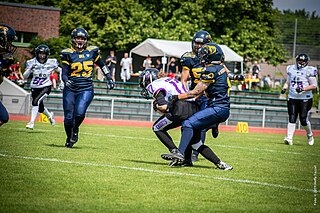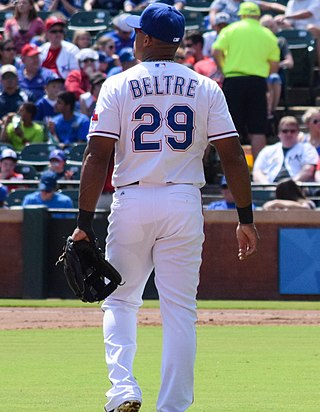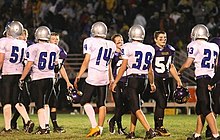In gridiron football, not all players on offense are entitled to receive a forward pass: only an eligible pass receiver may legally catch a forward pass, and only an eligible receiver may advance beyond the neutral zone if a forward pass crosses into the neutral zone. If the pass is received by a non-eligible receiver, it is "illegal touching". If an ineligible receiver is beyond the neutral zone when a forward pass crossing the neutral zone is thrown, a foul of "ineligible receiver downfield" is called. Each league has slightly different rules regarding who is considered an eligible receiver.

The quarterback, colloquially known as the "signal caller", is a position in gridiron football. Quarterbacks are members of the offensive platoon and mostly line up directly behind the offensive line. In modern American football, the quarterback is usually considered the leader of the offense, and is often responsible for calling the play in the huddle. The quarterback also touches the ball on almost every offensive play, and is almost always the offensive player that throws forward passes. When the QB is tackled behind the line of scrimmage, it is called a sack.

The tight end (TE) is an offensive position in American football, arena football, and Canadian football. It is a hybrid that combines the characteristics and roles of both an offensive lineman and a receiver. As part of the receiver corps, they play inside the flanks (tight), contrasted with the split end who plays outside the flanks (wide). Like offensive linemen, they are usually lined up on the offensive line and are large enough to be effective blockers. On the other hand, unlike offensive linemen, they are eligible receivers and potent weapons in a team's offensive schemes.

In American football, the placekicker, or simply kicker, is the player who is responsible for the kicking duties of field goals and extra points. In most cases, the placekicker also serves as the team's kickoff specialist and occasionally in youth football, also acts as the punter.

American and Canadian football are gridiron codes of football that are very similar; both have their origins partly in rugby football, but some key differences exist between the two codes.

Gameplay in American football consists of a series of downs, individual plays of short duration, outside of which the ball is or is not in play. These can be plays from scrimmage – passes, runs, punts or field goal attempts – or free kicks such as kickoffs and fair catch kicks. Substitutions can be made between downs, which allows for a great deal of specialization as coaches choose the players best suited for each particular situation. During a play, each team should have no more than 11 players on the field, and each of them has specific tasks assigned for that specific play.

In gridiron football, an official is a person who has responsibility in enforcing the rules and maintaining the order of the game.

Michael Troy Williams is an American former professional football player who was a wide receiver in the National Football League (NFL). He played college football for the USC Trojans, receiving consensus All-American honors in 2003. The Detroit Lions selected him in first round of the 2005 NFL Draft, and he also played in the NFL for the Oakland Raiders, Tennessee Titans, and Seattle Seahawks.
A formation in American football refers to the position players line up in before the start of a down. There are both offensive and defensive formations and there are many formations in both categories. Sometimes, formations are referred to as packages.

In football, the tackle-eligible play is a forward-pass play in which coaches will attempt to create mismatches against a defense by inserting an offensive tackle, into an offensive formation as an eligible receiver, usually as a tight end or as a fullback. This is done by changing the formation of the offensive line, via positioning two linemen on one side of the center and three linemen on the other.

In team sports, the number, often referred to as the uniform number, squad number, jersey number, shirt number, sweater number, or similar is the number worn on a player's uniform, to identify and distinguish each player from others wearing the same or similar uniforms. The number is typically displayed on the rear of the jersey, often accompanied by the surname. Sometimes it is also displayed on the front and/or sleeves, or on the player's shorts or headgear. It is used to identify the player to officials, other players, official scorers, and spectators; in some sports, it is also indicative of the player's position.

High school football, also known as prep football, is gridiron football played by high school teams in the United States and Canada. It ranks among the most popular interscholastic sports in both countries, but its popularity is declining, partly due to risk of injury, particularly concussions. According to The Washington Post, between 2009 and 2019, participation in high school football declined by 9.1%. It is the basic level or step of tackle football.

In baseball, the uniform number is a number worn on the uniform of each player and coach. Numbers are used for the purpose of easily identifying each person on the field as no two people from the same team can wear the same number. Although designed for identification purposes only, numbers have become the source of superstition, emotional attachment, and honor. In Major League Baseball, player and manager numbers are always located on the back of the jersey. A smaller number is often found on the front of the jersey, while umpires wear their numbers on the uniform shirt sleeve.
The A-11 offense is an offensive scheme that has been used in some levels of amateur American football. In this offense, a loophole in the rules governing kicking formations is used to disguise which offensive players would be eligible to receive a pass for any given play. It was designed by Kurt Bryan and Steve Humphries of Piedmont High School in California.
The following terms are used in American football, both conventional and indoor. Some of these terms are also in use in Canadian football; for a list of terms unique to that code, see Glossary of Canadian football.

American football, also known as gridiron football, is a team sport played by two teams of eleven players on a rectangular field with goalposts at each end. The offense, the team with possession of the oval-shaped football, attempts to advance down the field by running with the ball or throwing it, while the defense, the team without possession of the ball, aims to stop the offense's advance and to take control of the ball for themselves. The offense must advance at least ten yards in four downs or plays; if they fail, they turn over the football to the defense, but if they succeed, they are given a new set of four downs to continue the drive. A game is won by the team with the higher number of points, which are scored primarily by advancing the ball into the opposing team's end zone for a touchdown or kicking the ball through the opponent's goalposts for a field goal.
In gridiron football, an ineligible receiver downfield, or an ineligible man downfield, is a penalty called against the offensive team when a forward pass is thrown while a player who is ineligible to receive a pass is beyond the line of scrimmage without blocking an opponent at the time of the pass. A player is determined ineligible based on his position at the time of the snap. When the ball is snapped, the offense is required to have no more than eleven players on the field, out of whom only six are eligible. On most plays, the eligible receivers include the quarterback, running backs, fullbacks, tight ends, and wide receivers, while the ineligible receivers are offensive linemen, including the center, offensive guards, and offensive tackles. However, in the National Football League, a quarterback is an ineligible receiver if he is directly under the center when he receives the snap.
Players in the National Football League (NFL) wear uniform numbers between 0 and 99, with no two players on a team able to wear the same number outside of the offseason. Rules exist which tie a player's number to a specific range of numbers for their primary position. Additionally, rules exist which limit who may handle the ball on offense: generally players who are designated as offensive linemen, who wear numbers 50–79, are not allowed to handle the ball during a play from scrimmage, though they are allowed to do so if they report to the referee as playing out of position for a tackle-eligible play, if they pick up a fumble, or if they catch a deflected pass.

Will Reichard is an American football placekicker for the Minnesota Vikings of the National Football League (NFL). He played college football for the Alabama Crimson Tide, where he became the all-time NCAA Division I FBS scoring leader.
















